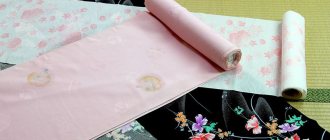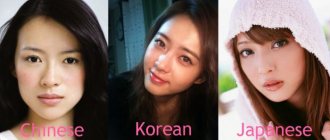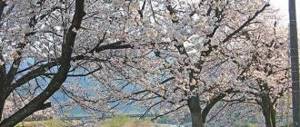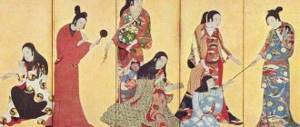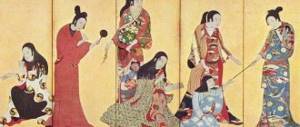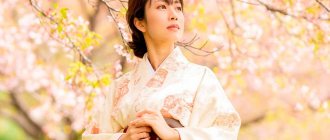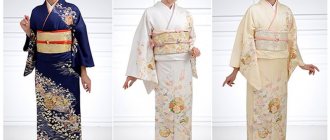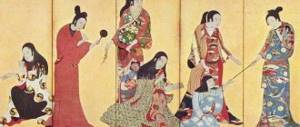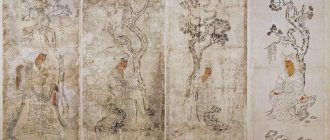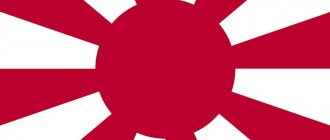Hello, dear readers! In today's article we will talk about what the national costume of Japan is. We have to understand the secrets of the origin of Japanese outfits and their components. Traditional Japanese clothing is extremely diverse in shape and purpose. The kimono, especially for women, is the most recognizable type of Japanese national costume, but it appeared in the form we know only in the first half of the last century. But what happened before this period?
How did the national attire change?
The first chronicles of the 8th century reported that the Japanese wore sleeveless white robes. Later, clothing was divided into two main directions: folk clothing and clothing for the nobility. Aristocrats wore costumes borrowed from China and Korea, while peasants perfected the national costume. Samurai belonged to the middle class and combined the aesthetics of aristocrats and ease of use in their wardrobe.
After some time, clothing began to be divided into men's and women's, this is due to the appearance of hakama and mo - traditional pants and skirts, without which most Japanese costumes now cannot be imagined. An interesting fact is that the Japanese did not want to accept these innovations, but imperial decrees obliged everyone to obey the new fashion.
In the 12th century, the kosode robe finally appeared. At this time, a “set” was formed, consisting of several layers of clothing tied with a belt. This has become a characteristic feature of women's and men's suits. The simplicity of the kosode was compensated by the art of its painting and decoration.
The Japanese Kabuki theater played an important role in the development of kimono. The actors were recognized trendsetters. They made everyday clothing more comfortable, practical, and more sophisticated for stage use, which was then adopted by observant citizens. For example, “the belt began to be tied above the waistline and it became wider, which gave the figure a stately and slender appearance.”
During the period of great geographical discoveries, European culture began to rapidly penetrate Japan. It was only in the 19th century, when Western clothing was recognized as official court dress, that traditional clothing began to be perceived as national.
The term “wafuku” is introduced - Japanese costume (和服・where “和” is “national” and “服” means “clothing”). The men's kimono becomes home wear, while the Western suit firmly takes its place as formal and work wear. It should be added that the word “和” is used very often in Japanese everyday life, emphasizing exclusively the national character. For example: 和食・“washyoku” - Japanese food, “和室”・“washitsu” - Japanese-style room, etc.).
It is worth noting that the introduction of European culture had a lesser impact on the position of women. Even now it is easy to notice the thread of the past. On all significant holidays, men are required to wear a formal suit, and women come in traditional outfits.
And now about the differences...
Since kimonos or yukatas are mostly worn by female representatives, instead of “residents of Japan” or “Japanese” we will use the unambiguous “Japanese”.
Material and price category
A kimono is a sign of a woman’s social status and her general position in society, and, according to the Japanese, this can be most clearly emphasized by only silk . That is why these robes are so expensive and can only be affordable by those who earn a decent amount of money.
But yukata is often made of cotton . It is not something that relates to the status of its owner; it serves as a common wardrobe item for any segment of the population. In addition, yukatas are often issued to guests of hotels, sanatoriums and resorts.
Drawing
Kimono is famous for its beauty and is especially valued by Japanese women for the presence of original patterns and designs on the fabric. The combination of colors, shades and style is recognized as a real art, which can richly decorate not only a piece of fabric, but also the wearer of silk clothes herself.
With regard to yukata, everything is different: it can also have a pattern, but in most cases it is absent . Its presence or absence depends on the purpose of a particular yukata, but more on that later.
The length of the sleeve
A kimono is distinguished by the obligatory presence of long sleeves , while in a yukata it can be quite short - this is done for the convenience of wearing and moving the user.
Collar
A kimono , according to traditional tailoring, must have at least two collars . And yukata has one - again, with the aim of increasing the comfort of staying in this type of clothing.
Purpose
As a rule, people wear a kimono when they are about to go out into the world : for a holiday or for the purpose of hosting a worthy reception of guests, and so on. Yukatas come in two types:
- for sleeping or wearing after water procedures (simple cotton fabrics can serve as an excellent analogue of a dressing gown);
- for holidays (in Japan in the summer , and therefore many girls and women prefer to wear yukata to summer festivals and other celebrations rather than stuffy and heavy kimonos).
Thus, now we can definitely say that kimono and yukata are not the same thing. Perhaps this interesting information will be useful to you in the future and will help you avoid an awkward situation.
If you are still closer to the European style, but the comfort and softness of the fabrics is also important, pay attention to Ivanovo knitwear. This is high quality knitwear from the manufacturer. There are women's knitwear, men's knitwear, teenage knitwear, more details at the link.
(Visited 225 times, 1 visits today)
Geisha - trendsetters of traditional fashion
Speaking about how the Japanese national style developed, one cannot fail to mention courtesans and geishas. Along with the actors, they created fashion. The kimonos of courtesans and geishas were made from the best fabrics and decorated in an appropriate manner, and their owners were considered ideals of beauty and aesthetics. The class affiliation of girls was distinguished by wearing a kimono. For example, a bow on a geisha’s belt was worn at the back, while among courtesans it was tied in front for the convenience of untying it for well-known purposes.
How to wear
Before putting on a yukata, you need to remember a simple procedure:
- The robe is thrown over the shoulders, hands are inserted into the sleeves. It is important to smell the floors from left to right - on the contrary, they only do it for the deceased.
- The belt is wrapped around the waist, starting from the stomach. The obi on the yukata is tied at the front, its ends should be the same length.
- Women leave the belt at the waist, and men lower it lower. The node should be located on the right side.
It is not customary to wear national Japanese robes with loose long hair.
Costume components
An integral part of the kimono is the obi belt, with which it has been tied since the very period of its inception. It is considered a kind of amulet that protects the soul, and the knot of the belt is a symbol of true love. The T-shaped robe can vary in length depending on the cut and can be skillfully tucked under the obi at any time to make the outfit shorter. The sleeves are sode, much wider than the arms and have a baggy shape. What was special was that the hole for the arm had to be less than the height of the sleeve.
Japanese outfits are characterized by excessive layers. The kimono is made of fabric about 40 cm wide and 11.5 m long. The finished “dress” consists of four stripes: the first pair of stripes was needed to cover the body, and the rest were used for the sleeves and stripes for the collar.
Traditional dresses are made of silk, and in some cases satin is used.
80% of Japanese have worn it at least once, 40% have their own kimono
According to a 2011 study (link in Japanese), about 80% of respondents had worn a traditional outfit at least once in their lives, but only 40% said they owned their own kimono. The pace of modern life has accelerated greatly, and the occasion to wear the Japanese national dress appears infrequently - about half of those surveyed reported wearing a kimono less than once every five years.
Traditional Japanese clothing is made from tammono (the so-called long solid piece of fabric measuring 0.36 x 12 m), which is cut into several rectangular pieces and then sewn in a certain way. A kimono can be “recycled”, for example, by adjusting it to a child’s height, or altering a parent’s kimono into a kimono for a child. Thus, the national costume, preserving its pristine beauty, is inherited from generation to generation, from parents to children.
Colorful tammonos
Traditional accessories
The shirt worn by both men and women as underwear is called nagajuban. It is needed to ensure that the silk kimono does not touch the skin of the wearer. Women wore under a nagajuban, underwear resembling a T-shirt - hadajuban and thin pantaloons - sasoyoke.
A striking element of the Japanese costume is considered to be traditional shoes: wooden geta sandals, with a peculiar sole, worn only under a yukata. And also zō:ri - “flip-flops” with flat soles, worn with both outfits (pictured on the left), but required for kimono. It is impossible not to mention kanzashi (some call them kanzashi) - women's jewelry that completed the look and was attached to the hair. While wearing zōri, white socks with a separate tabi toe were worn on the feet.
National costume for every day
This folk costume is a light robe wrapped around the body and secured with a belt in the form of a strip of fabric. Literally translated, yukata means bath clothing and was used to cover the body after bathing in a public bath. Modern Japanese wear it both at home and outside in hot weather.
The material used for the robe is:
- cotton;
- linen;
- hemp (fiber from hemp stems);
- synthetic fiber.
Japanese people in these clothes can often be seen during festivals or in cities where hot springs flow. National attire is also offered to guests of traditional Japanese hotels.
Yukata is worn by everyone, regardless of gender. The men's robe looks strict and is painted in dark colors. Women's - bright, decorated with drawings and patterns, additional decorations and objects are attached to it.
Difference between kimono and yukata
Yukata is an unlined cotton kimono worn in the summer (on the left in the photo). The main difference is in the fabric: kimono is made of silk, and yukata is made of cotton, they are similar in style, but yukata does not have long sleeves and complex patterns.
Yukata is worn in hot weather, during summer holidays, and is rarely used as home wear. Instead of two layers, the clothing is made in a single layer and is shorter in comparison to a kimono.
There are several negative features of wearing a kimono:
- a kimono is very difficult to put on by yourself, without outside help; the whole process takes about half an hour;
- you cannot sew it yourself;
- inheritance traditions have become difficult to maintain due to the penchant of young people for comfortable European clothing.
Thus, nowadays the kimono is more of a historical and festive character than an everyday one.
History of yukata
It is said that yukata comes from the word "yukatabira", which was a clothing used to protect oneself from being burned by steam while visiting steam baths in the Heian era. Yukatabiras were also used for wiping. During the Edo period, the yukatabira became a common form of dress for visiting public baths. This is largely why there are still people who say “yukata is not streetwear.”
However, in the modern world, the functions of the yukata have changed. From the middle of the Showa era (1926-1989), a new culture of “easy-to-wear kimono” began to emerge. Yukata became a popular garment among the younger generation, giving rise to "Yukata culture".
Interesting Facts
If you fold a kimono correctly and in the right chronology, you will get a rectangle. In this way, accuracy is cultivated in a person. A bow is one of the main decorations of a woman’s costume, so a lot of love is put into the tying procedure. This part of the outfit was often sung in poetry. The smell of the kimono should be exclusively on the right side! With the smell to the left, a kimono can only be seen on a deceased person during a funeral.
It has long been considered bad manners if a girl in a traditional costume accidentally shows a bare part of her body that was usually hidden under clothing (for example, her legs). This rule equalized women of all ages, both with each other and with others. But at the same time, in a traditional costume, there is a detail that openly emphasizes feminine charm - this is a specially lagging “neckline” that reveals the woman’s neck at the back. And hair gathered into a hairstyle skillfully enhances the attractiveness of female features.
I hope you found a lot of useful and interesting information by reading the article, share what you read with your friends, subscribe to the blog and learn a lot of new things every day! All the best and see you soon!
Lika Raido
Where to buy a yukata?
In Japan, yukata are sold all year round, but their popularity peaks, of course, in the summer. Both Rakuten and Amazon offer a wide selection of yukata. You can also look for a yukata you like in specialized stores:
https://www.kimonomachi.co.jp/
https://araiya.mobi/
(instructions on how to buy in specialized Japanese stores.)
Here you can look at several nice options for different budget categories that Japanese stores offer.
Women's Yukata
Bright, original sets of women's yukata can be found here
